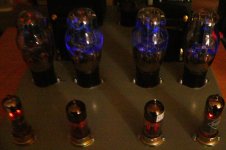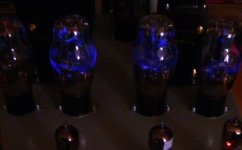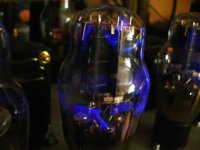Below are photos of three different 2A3 tubes recently purchased at a particular online auction site, all of which exhibit different glows when under test on my MaxiMatcher (Vp=325v & Vb=-60v).
It is my understanding that
What are your thoughts and analyses?
Would you use any of the tubes below with amps and speakers you cared about?
Thanks,
John



EDIT: Photos are high res, and the forum software may be squishing them, so if needed, click on an image to unsquish.
It is my understanding that
- blue glow on the glass is OK
- blue glow on the mica or supports is questionable
- purple glow anywhere is bad.
What are your thoughts and analyses?
Would you use any of the tubes below with amps and speakers you cared about?
Thanks,
John



EDIT: Photos are high res, and the forum software may be squishing them, so if needed, click on an image to unsquish.
Last edited:
I've seen similar on a handful of both NOS and new production tubes, and they lasted a good long while without issue. I wouldn't worry.
Get a can of black spray paint and paint over the glass.What are your thoughts and analyses?
Would you use any of the tubes below with amps and speakers you cared about?
If I was concerned about the glow, I would test for grid leakage. With your test parameters, connect the grid to ground though a 1M resistor and measure the voltage across it. A good quality meter will have an impedance of 10M and won't influence the measurement much.
I did not look on the 2A3 tube curves, so do not know what current you had at 325V and -60V.
The resultant I x V is probably less than the 15W maximum power rating.
Of course under real signal conditions the plate might go to as high as approximately 500V.
But I have had 2A3s, 6A3s, and 300Bs that glowed that way. They worked fine.
Some of them "dance" with the music.
There are things you can do for when an amp has a shorted tube:
My amps have 2 fuses in series with the power transformer primary winding. 1 fuse is a fast blow barely large enough to not blow at the inrush current at turn-on. The other fuse is a slow blow barely large enough to not blow during the current the amp draws when warmed up.
If the fuses blow before there is damage to power transformer, output transformer, rectifiers, you are generally OK.
If instead a tube Arcs/oscillates, you may get a lot of power sent to the loudspeaker.
Once I had a 45 that did this, but I was there to turn the amp off before it damaged the tweeter (and my ears).
The resultant I x V is probably less than the 15W maximum power rating.
Of course under real signal conditions the plate might go to as high as approximately 500V.
But I have had 2A3s, 6A3s, and 300Bs that glowed that way. They worked fine.
Some of them "dance" with the music.
There are things you can do for when an amp has a shorted tube:
My amps have 2 fuses in series with the power transformer primary winding. 1 fuse is a fast blow barely large enough to not blow at the inrush current at turn-on. The other fuse is a slow blow barely large enough to not blow during the current the amp draws when warmed up.
If the fuses blow before there is damage to power transformer, output transformer, rectifiers, you are generally OK.
If instead a tube Arcs/oscillates, you may get a lot of power sent to the loudspeaker.
Once I had a 45 that did this, but I was there to turn the amp off before it damaged the tweeter (and my ears).
Last edited:
I have some Svetlana 6C4C (bought cheap before the price ballooned) and a pair of Electra-Print output transformers designed for a triode push-pull. It would be interesting to design a no-feedback amp based on these once I decide on an input stage. I also like that I might be getting some blue glow for my trouble. Maybe it's time to trot out my 6n6ps....
my 6n13s (russian 6AS7G's) have a wonderful blue glow that will dance lightly on heavy signal input, very handsome.
- Status
- Not open for further replies.
- Home
- Amplifiers
- Tubes / Valves
- Tube Glow


